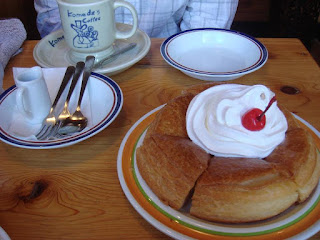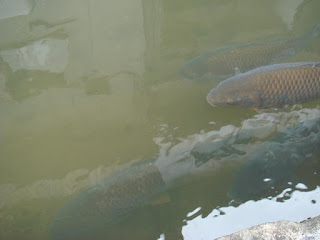Next morning, we visited Tokugawa Garden where we didn’t have time to go on the other day, and Sakae District where my friend often said it’s comparable to Downtown Robson in Vancouver. But first my friend took me to Komeda’s coffee since I wanted to try Japanese style breakfast in a coffee shop. It was just few blocks from my hotel in Marunouchi 丸の内.




Based on my web research, the Nagoya-based coffee shop Komeda コメダ珈琲店 is one of the largest coffee house chains in Central and Western Japan. Komeda was established in 1968 and to be different from other modern coffee chains such as Starbucks, Komeda's coffee shops feature old-fashioned atmosphere with wooden walls and furniture, magazine rack and an old style menu. Staffs would take customers’ orders at their tables. Same as some Japanese restaurants, customers are allowed to smoke in the coffee shop.
The menu was very colourful! It offered hotdogs, sandwiches, salads, snacks, pastries, hot lemon tea, hot and ice coffee, etc. Let’s try its feature breakfast combo: purchase of a drink with complimentary set of a boiled egg and buttered toast (好低呀! 買飲品送隻蛋同多士!). I also tried its famous Shirono-whirl which was a Danish pastry topped with soft ice cream plus a cherry.



After the nice simple breakfast, we took subway transit to Ozone Station 大曽根 and then walked for 15 minutes to the Japanese garden: Tokugawaen 徳川園.
Tokugawaen or Tokugawa Garden 徳川園 is a nice example of chisenkaiyu style garden in Edo period (江戶時代的池泉回遊式庭園) where a path is surrounding a pond. It was like a stroll garden with view and perspective changing as we wandered along the path. Admission fee was only ¥ 300, less than 4 bucks in CAD!
The garden was built in 1695 as a retirement villa for Tokugawa Mitsutomo 徳川光友, the second lord of Owari (today’s western part of Aichi Prefecture) 尾張藩第二代藩主. Tokugawa Mitsutomo’s father Tokugawa Yoshinao 徳川義直 (the first lord of Owari) was the 9th son of Tokugawa Ieyasu 徳川家康, the significant Japanese warrior who founded the Tokugawa dynasty of shoguns 德川時代 (or called Edo period 江戸時代) in Japan. Tokugawaen was destroyed in World War II and reopened as a Japanese garden in 2004.
I could see the rocks, plants and bridges were arranged elegantly to reflect the beauty of Japanese nature. Let’s name some of the photos above from left to right:
1st photo - Tiger's Tail River (虎の尾/ TORA NO O)
2nd photo – Ozone Waterfall (大曽根の瀧/ OZONE NO TAKI) where a three-tiered waterfall of 6m can be found at the upstream of Tiger’s Tail River. The mountain behind the waterfall is the highest mountain in Tokugawaen.
4th photo – Sei Lake Bund (西湖堤/ SEIKOTEI) is a miniature of the levee parting the lake surface of West Lake in Hangzhou, China. I think it is the imitated Su Causeway (仿蘇堤) since the Japanese brochure mentioned the name 蘇東坡. I’ve been to Hangzhou West Lake but it was in a rush that I couldn’t pay detailed attention to all the scenic spots so I’m really not too sure which causeway is imitated here.
Anyways there are similarities and differences between Chinese and Japanese gardens. Early Japanese gardens were modeled upon Chinese gardens, gradually Japanese gardens had their own distinct appearance.
5th photo – Koi pond (錦鯉/ Nishikigoi in pond). They were all swimming toward me for food. .. sorry I got nothing to feed them.
5th photo – Koi pond (錦鯉/ Nishikigoi in pond). They were all swimming toward me for food. .. sorry I got nothing to feed them.
Photo on top of “Trip to Japan (Part 7)”– me by the Dragon’s Gate Waterfall (龍門の瀧/ RYUMON NO TAKI), the name is derived from a legend of fish transforming into dragon after swimming up to the top of the waterfall.


As a typical Japanese garden, there is a central pond called Ryusen Lake (龍仙湖) surrounded by waterfalls, trees, rocks, bridges and a tea house.
I saw a wedding couple in traditional costume 和服 in Tokugawaen! It reminded me that I’ve encountered a few women wearing Japanese costumes known as kimono around Nagoya station and in Takayama. My friend told me that the young generations don’t know how to wear Japanese costumes since they have no idea how to tie the obi 腰帶 with a knot at the back. Obi is a belt that ties kimono.
Walking back to Ozone Station, I saw a restaurant with an outdoor menu so I took a photo for reference of authentic Japanese food J

Next we visited Oasis 21 which was just right by Sakae Station 榮. Oasis 21 is one of Nagoya's most innovative complexes in downtown Sakae since its opening in 2002. It contains restaurants, shops, tourist information centre and bus terminal below the ground. Above the ground I could see its oval-shaped glassy roof filled with water called “Water Spaceship”.
According to web, there are several benefits of the Water Spaceship. It is filled with water to create an interesting visual effect and to cool down the temperature of the shopping area below in the summer. Visitors can enjoy the view of Sakae district while walking on the roof.

On the Water Spaceship, I could see ferris wheel and Nagoya TV tower. After a while we walked down to buy fries at MacDonalds in Oasis 21. Since it was a family day (no school and work in Golden Week), there were lots of kids and lots of activities going on.

My friend suggested to try the giant ferris wheel 摩天輪 at Sunshine Sakae building. Let’s go …
During the 15 minute ride, I could see the whole downtown Sakae clearly from the top. I saw a few international brands such as Brother, Citibank, Coach and Louis Vuitton. It’s a very organized modern city!
After the ride, we walked along the street to Matsuzakaya department store 松坂屋. It was the only time I felt myself in the real modern Japan … a youth band playing in park, huge outdoor screen and the listen of pop Japanese songs on street. Even though the city was very clean, unpleasant smell was suddenly around.
Many souvenir shops in Matsuzakaya were selling rice cakes wrapped in oak leaves 柏餅 or mom gifts as Boy’s Day and Mother’s Day were approaching at that time. In Japan, samples were labelled as 見本. I think in Chinese society, we label the samples as 樣本. Just one word difference.
Time for my last supper in Japan 最後的晚餐, we both voted for buffet in 草楽 on the 9th floor of Matsuzakaya! ¥ 2480 each = CAD 31.00 (not cheap hey but I don’t think it’s too expensive compared to University Golf Club in Vancouver. With about the same price, 草楽 had more dishes).
The restaurant claimed that they use seasonal ingredients without any additives to meet the health and natural concept. Sounds Good!




Now I don’t quite remember what they provided … I only recall roasted beef, nigiri sushi, some local vegetables, carrot, potato, noodles, tempura, hot soup, cakes and desserts, tea, juice and red wine …
We stayed there from 5:30 pm till almost 7:30 pm and the restaurant was only 40% occupied, less customers than I expected. Still I enjoyed the buffet in this quiet and relaxing environment … no need to fight for food … hehe!
Time flew by too fast, next day was already May 5 … my departure day L
I wore another jacket for the colder weather in Vancouver. While I went to the washroom in Chubu Centrair International Airport, I found a bag of 八仙果 in the pocket of my jacket. 八仙果 is like a licorice menthol of eight fruit and herbal ingredients for the purpose of comforting sore throat. Oh yeah … my mom gave it to me for my travel. This was the famous 李錦利八仙果 from Taiwan made of grapefruit, kumquat, Chinese date, orange peel, licorice, Buddha’s hand citron, peppermint, maltose (葡萄柚、金桔、金棗、陳皮、甘草、佛手果、薄荷、麥芽).
To express gratitude to my friend, I decided to give him the bag of 八仙果. His first response was “poopoo from the washroom?” (一舊舊屎???) Oh No … I was just coming out from washroom and the pieces of 八仙果 were in dark brown colour, no wonder my friend thought of feces.
Overall, this short vacation to Japan was quite fun with the travel from tourist attractions to local neighbourhood, from the ocean to the mountains, from the city to the countryside and from the historical district to the modern place. It was like travel from 21st century back to the Edo period and then return to the present time again!






















































